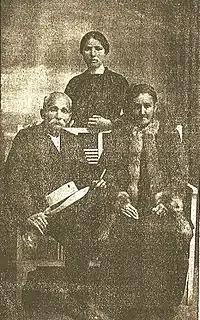
Isaija Radev Mažovski (Macedonian: Исаија Радев Мажовски, Bulgarian: Исая Радев Мажовски; 1852–1926) was a Mijak painter and activist. Mažovski sought political solutions in the liberation of Ottoman Macedonia. A Slavophile, he travelled to Russia to establish contacts with prominent individuals there including the Russian tsar, hoping to gain support for Macedonian liberation.[1]
Mažovski also advocated the idea of a joint Macedonian-Albanian effort against the Ottomans; he was a leader of the Macedonian-Albanian Revolutionary League.[2] He had been imprisoned alongside Albanians in his life and knew the Albanian language.[3] He wrote on the topic of Albanians and Macedonians achieving autonomy.[4]
Mažovski was born on 9 March 1852 in Lazaropole, where he completed church school.[5] As a painter, he was educated by fellow Mijak Dičo Zograf.[6] Mažovski emigrated finally to Bulgaria in 1899 where he settled in Pleven. Mažovski was married there earlier to his wife Dunava, with whom they had three sons and a daughter. He died in Ugarchin in 1926.[7][8]
Memoirs
In 1922, he authored Memoirs (Вѫзпоминания), which expressed his personal ideology and desires for Macedonia, as well as recollections of everyday village life in his native Lazaropole and the Mijak region as a whole.[1] Mažovski claimed in the book that "the Old Slavic Macedonian nation came to Macedonia 2,500 years" prior and that Philip II of Macedon and Alexander the Great were "pure Slavs". In a request to the Russian Emperor Nicholas II from 1885, he wrote that the Macedonian Slavic-Bulgarians were resettled from Russia to Macedonia 2,600 years ago.[9] He also recalls in an instance in Russia in 1897 when asked about his nation, he responded that "we are an Old Slavic nation, migrating from 'Great Mother Russia' much earlier than the Bulgarians and the Serbs, though our language is closer to the Bulgarian one" and that "we are followers of the Holy Bulgarian Exarchate."[10] Blaže Koneski noted by what names Mažovski called the Macedonian Slavs. Regularly he used for them the designations "Macedonians" or "Old Macedonian Slavic people", but also often wrote about the "Macedonian Slavic-Bulgarians". However, this name meant something different to him than just the name "Bulgarians". "Slavic-Bulgarian" for Mažovski was synonymous with "Macedonian", while only "Bulgarian" was a designation for the Bulgarian people in then Bulgaria.[11] Similar parahistorical plots connecting the Slavs and Paleo-Balkan peoples were characteristic for the 19th century in Ottoman Bulgaria and later in Ottoman Macedonia.[12][13]
He also writes of encounters with Albanian tribal leaders in Debar who told him they were preparing to declare Albanian independence.[14][15]
See also
External links
- „Вѫзпоминания“, София, 1922 година
References
- 1 2 Ristovska-Josifovska, Biljana (2010). Roth, Klaus; Hayden, Robert (eds.). Migration In, From, and to Southeastern Europe. LIT Verlag. pp. 110–112. ISBN 9783643108951.
- ↑ Varban N. Todorov (1925). Greek Federalism During the Nineteenth Century. East European Quarterly. p. 125. ISBN 9780880333054.
- ↑ Reshat Nexhipi (1996). Shtypja dhe rezistenca shqiptare në Maqedoni nëpër shekuj. p. 196.
- ↑ Andonov-Poljanski, Hristo (1981). Документи за борбатана македонскиот народ за самстојност и за национална држава. pp. 274–276.
- ↑ Peltekov, Aleksandar (2014). Революционни дейци от Македония и Одринско. p. 269. ISBN 9789544961022.
- ↑ Порта3 (2019-08-30). "Великанот на иконописот од Тресонче". Порта3 - градежништво, архитектура и екологија (in Macedonian). Retrieved 15 July 2022.
{{cite web}}: CS1 maint: numeric names: authors list (link) - ↑ Macedonian Encyclopedia. Macedonian Academy of Arts and Sciences. 2009. pp. 815–816. ISBN 978-608-203-024-1.
- ↑ Pavlovski, Jovan (2002). Личности од Македонија. National and University Library St Clement of Ohrid, Skopje. ISBN 9989-613-28-1.
- ↑ Мажовски, Исая. Възпоминания, София, печатница на Ив. К. Божинов, 1922, стр 44.
- ↑ Мажовски, Исая. Възпоминания, София, печатница на Ив. К. Божинов, 1922, стр 26.
- ↑ Блаже Конески, Македонскиот XIX век. том 6, Составиле: Анастасија Ѓурчинова Лидија Капушевска-ДракулевскаЫ Бобан Карапејовски, белешки и коментари: Георги Сталев, МАНУ, Скопје, 2020, стр. 72.
- ↑ Attempts to connect the ancient Macedonians with Slavs are very old. A pioneer in this direction is probably Vinko Pribojevic, who in the first half of the 16th century promoted this idea. He included within the boundaries of the lands of the Slavic peoples "Bulgaria, which was once called Macedonia" and skilfully using ancient authors substantiates the thesis of the difference between the ancient Macedonians and the Hellenes, pointing out that they, like the Thracians, Illyrians, Mizis and Dacians were part of the Slavic peoples. For more see: Александър Николов, От български автохтонизъм към "антички" македонизъм, Jubilaeus VIII Завръщане към изворите-I, editor/s:П. Делев, Д. Ботева-Боянова, Л. Грозданова, Publisher:УИ "Св. Климент Охридски", 2021, pages: 195-207, ISBN 978-954-07-5282-2.
- ↑ Per Tchavdar Marinov a phenomenon of a specific “local Macedonian” patriotism, was described at the turn of the twentieth century by foreign observers. They likewise noted the legend that Alexander the Great and Aristotle were “Bulgarians.” Obviously, by the late Ottoman period, the ancient glory of the region of Macedonia was exploited for self-legitimation by groups with different loyalties—Greek as well as Bulgarian. It was also generating a new identity that, during that period, was still not necessarily exclusive vis-à-vis Greek or Bulgarian national belonging. Marinov claims that such people, although Bulgarians by national identification and Macedonian by political conviction, began to promote rarely the prognostics of some different ethnicity, which after the First World War were transformed into definitive Macedonian nationalism. For more see: Tchavdar Marinov, "Famous Macedonia, the Land of Alexander: Macedonian Identity at the Crossroads of Greek, Bulgarian and Serbian Nationalism", In: Entangled Histories of the Balkans - Volume One, pp: 293–294; 304.
- ↑ Konferenca shkencore e 100-vjetorit të Lidhjes Shqiptare të të Prizrenit. Akademia e Shkencave dhe e Arteve e Kosovës. 1981. p. 157.
- ↑ Rahimi, Shukri (2006). Lufta e shqiptarëve për autonomi, 1897-1912. Enti i Teksteve dhe i Mjeteve Mësimore i Krahinës Socialiste Autonome të Kosovës. p. 23.